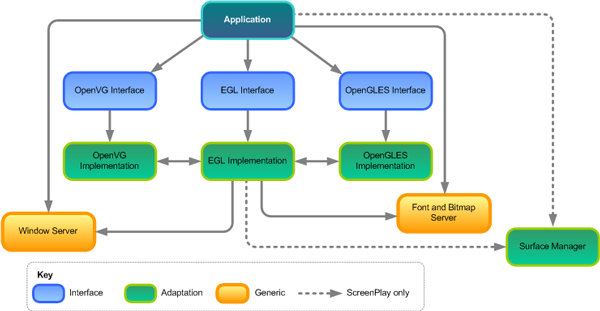EGL Collection Overview
EGL is an interface between EGL client APIs (such as OpenGL ES and OpenVG) and an underlying native platform window system. EGL is independent of definitions and concepts specific to any native window system or rendering API.
EGL is an open standard developed by the Khronos Group, which is a member-funded industry consortium. Khronos creates open standard, royalty-free APIs to help write and execute dynamic media on a wide variety of platforms and devices. For more information about EGL operations, functions, errors, versions and header files, see http://www.khronos.org/egl/.
In this documentation the term EGL client API is used to mean a rendering API, such as OpenGL ES or OpenVG, that is a client of EGL.
Introduction to EGL on the Symbian platform
EGL provides:
Mechanisms that create rendering surfaces onto which EGL client APIs can draw and which they can share.
Methods that create and manage graphics contexts for EGL client APIs.
Methods that synchronize drawing by EGL client APIs and Symbian APIs (such as
CWindowGc).
One of the purposes of EGL is to provide a means to create
EGL client API rendering contexts, and associate them with drawing
surfaces. EGL defines three types of drawing surfaces collectively
referred to as EGLSurfaces. These are:
Window surfaces, which are used for on-screen rendering into windows that are provided by the Symbian platform (rather than EGL) .
Pbuffer surfaces, which are used for off screen rendering and are entirely provided by EGL.
Pixmap surfaces, which are used for off screen rendering into pixmap buffers that are provided by the Symbian platform (rather than EGL).
Some key points to note include:
EGL objects and their related context state cannot be used outside of the address space in which they are created.
EGL enables sharing of certain types of context state among contexts existing in a single address space.
Thread-safety
Currently EGL and its client APIs are only guaranteed to work correctly on the Symbian platform when they are within a single thread. EGL guarantees sequential ordering within a command stream for each of the EGL client APIs. However, there is no guarantee of sequential ordering between EGL client APIs and Symbian APIs which render into the same surface.
EGL client API commands may be asynchronous, in order to prevent impairing the interactive use of the windowing system by the user. For example, otherwise rendering a large texture mapped polygon on a system with no graphics hardware, or drawing a large OpenGL ES vertex array, could prevent a user from invoking a menu soon enough to be usable.
Synchronization depends on the client—it can be maintained at
moderate cost with the careful use of commands such as glFinish, vgFinish, eglWaitClient, and eglWaitNative, as well as synchronization commands present
in the Symbian APIs. The EGL client API and Symbian API rendering
can be done in parallel if the client does not prevent it with explicit
synchronization calls. Some performance degradation may be experienced
when there is unnecessary switching between EGL client APIs and Symbian
API rendering.
Architectural relationships
The following diagram shows the key EGL relationships and dependencies within the Symbian platform. On the Symbian platform, OpenGL ES, OpenVG and EGL all have a component (shown in blue) that declares the interface, and all require an implementation that implements that interface (shown in green).

Figure: Key EGL relationships and dependencies
The EGL Interface component provides a consistent interface to EGL on the Symbian platform, enabling cross-device compatibility. The component includes the Khronos-released header files (which incorporate some minor changes, such as to the comments). It also provides some Symbian-specific header files and some other files (such as LIB, DEF and MMP files) and UIDs. It does not provide any implementations of the APIs.
The EGL Interface component includes the header files for EGL 1.2, 1.3 and 1.4 (which is used by default). The main advantage of EGL 1.4 over previous versions is the introduction of a preserve buffer flag. When supported by the implementation, an EGL window surface can have its color buffer preserved from one frame to the next. This means that the client does not need to send the entire drawing instructions for each frame. Instead the client can simply send the drawing operations for what changes in each frame compared to the previous one. This can reduce the memory footprint and the CPU overhead when an EGL client API renders successive frames.